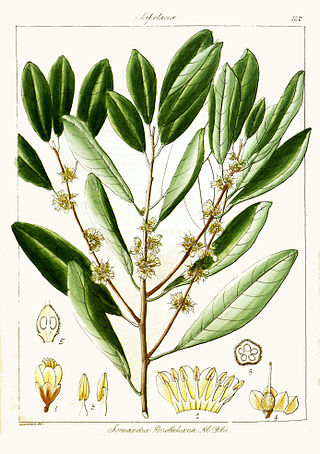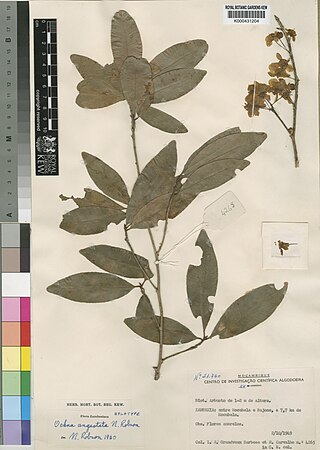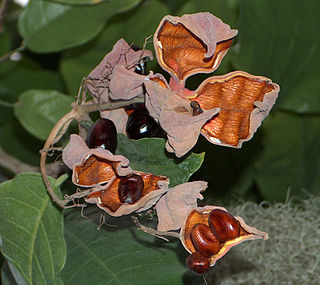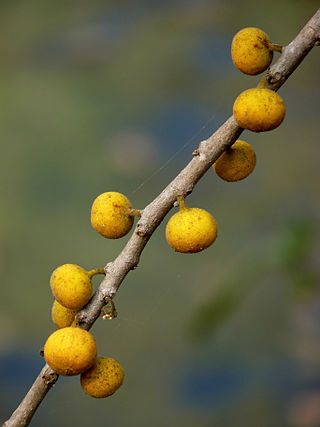
Ochnaceae is a family of flowering plants in the order Malpighiales. In the APG III system of classification of flowering plants, Ochnaceae is defined broadly, to include about 550 species, and encompasses what some taxonomists have treated as the separate families Medusagynaceae and Quiinaceae. In a phylogenetic study that was published in 2014, Ochnaceae was recognized in the broad sense, but two works published after APG III have accepted the small families Medusagynaceae and Quiinaceae. These have not been accepted by APG IV (2016).

Ochna is a genus comprising 79 species of evergreen trees, shrubs and shrublets belonging to the flowering plant family Ochnaceae. These species are native to tropical woodlands of Africa, Madagascar, the Mascarenes and Asia. Species of this genus are usually called ochnas, bird's-eye bushes or Mickey-mouse plants, a name derived from the shape of the drupelet fruit. The name of this genus comes from the Greek word ὄχνη (ókhnē), used by Theocritus and meaning "wild pear", as the leaves are similar in appearance. Some species, including Ochna integerrima and O. serrulata, are cultivated as decorative plants.

Ochna integerrima, popularly called yellow Mai flower, is a plant species in the genus Ochna and family Ochnaceae. In the wild, it is a small tree or shrub species. The timing of the yellow flowers of this plant make it very popular in southern Vietnam, where plants are purchased during Tết.
Aporosa lanceolata is a species of plant in the family Phyllanthaceae. It is endemic to Sri Lanka.

Campylospermum serratum is a plant in the family Ochnaceae. The specific epithet serratum is from the Latin meaning "with teeth", referring to the leaf margin. It is found in Tropical Asia, from Sulawesi, Indonesia to Hainan, Zhōngguó/China and over to southwester India. Gomphia serrata was a previous common name for the species. The plant is used for it wood and its sap is used in folk medicine and in the past for teeth-blackening.

Isonandra is a genus of plants in the family Sapotaceae found in tropical Asia, described as a genus in 1840.

Ochna angustata is a species of plant in the family Ochnaceae. It is endemic to Mozambique.

Ochna beirensis is a species of plant in the family Ochnaceae. It is endemic to Mozambique.

Ochna serrulata is an ornamental garden plant in the family Ochnaceae which is indigenous to South Africa. It is planted in southern African gardens and is an invasive species in Australia and New Zealand.

Ochna pulchra, also known as Lekkerbreek, is a small deciduous southern African tree up to 5 m, commonly found on deep sandy soil and rocky slopes, and belonging to the tropical family of Ochnaceae, which is widespread in Asia and Africa.

Sirhookera is a genus of flowering plants from the orchid family, Orchidaceae. Two species are known, native to India and Sri Lanka.
Diospyros atrata is a tree in the Ebony family. It commonly grows to 25 metres tall. The plant can be seen in subcanopy trees in medium elevation wet evergreen forests between 1000 and 1400 m in Western Ghats- South Sahyadri, Kerala, and Tamil Nadu in India and from Kandy district in Sri Lanka
Suregada lanceolata is a species of plant in the family Euphorbiaceae. It is native to India and Sri Lanka.

Actinodaphne quinqueflora is a species of plant in the family Lauraceae. It is native to Southern Western Ghats of India and parts of Sri Lanka. Its leaves are simple, alternate; lamina obovate to oblanceolate or elliptic; apex obtuse to acute; base acute to cuneate with entire margin. The flowers show umbel inflorescence, and the fruit is a one-seeded berry. The plant is known as "Wal kos / Kosbada / Landittan - වල් කොස් / ඛොස්බඩ / ලන්දිට්ටන්" by Sinhalese people in Sri Lanka.

Persea macrantha, the large-flowered bay tree, is an evergreen tree in the laurel family (Lauraceae), native to southwestern India and Sri Lanka.

Pterospermum suberifolium, or the cork-leaved bayur, is a species of evergreen flowering plant in the family Malvaceae. It is found only in India and Sri Lanka. Leaves are irregularly oblong; subcordate, rounded or oblique; apex acuminate; with irregularly serrated margin. Its flowers are yellowish white and fruit is a capsule.

Sterculia balanghas is a species of plant in the family Malvaceae. It is native to India and Sri Lanka. Leaves are simple, alternate; swollen at base and tipped; lamina elliptic, obovate, oblong, elliptic-ovate or oblong-ovate; base subcordate or round; apex acuminate; with entire margin. Flowers may be unisexual or polygamous are yellow or greenish-purple in color. Inflorescence show terminal or axillary panicles. Orange to red colored fruit is oblong and seeds are black in color.
Memecylon angustifolium, or blue mist, is a species of plant in the family Melastomataceae. It is native to India and Sri Lanka. Leaves are simple, opposite, decussate; lamina narrow linear-elliptic to linear-lanceolate; apex acute, base attenuate, with entire margin. Flowers are blue in color and show axillary umbels inflorescence. Fruit is a blackish purple, one-seeded berry.

Ficus exasperata, also called the sandpaper tree, forest sandpaper fig, white fig, or sandpaper leaf tree, is a deciduous, and dioecious species of plant in the mulberry family Moraceae, native to tropical Africa and southern Asia.
Eugenia mooniana, is a species of plant in the family Myrtaceae which is native to Western Ghats of India and Sri Lanka.















